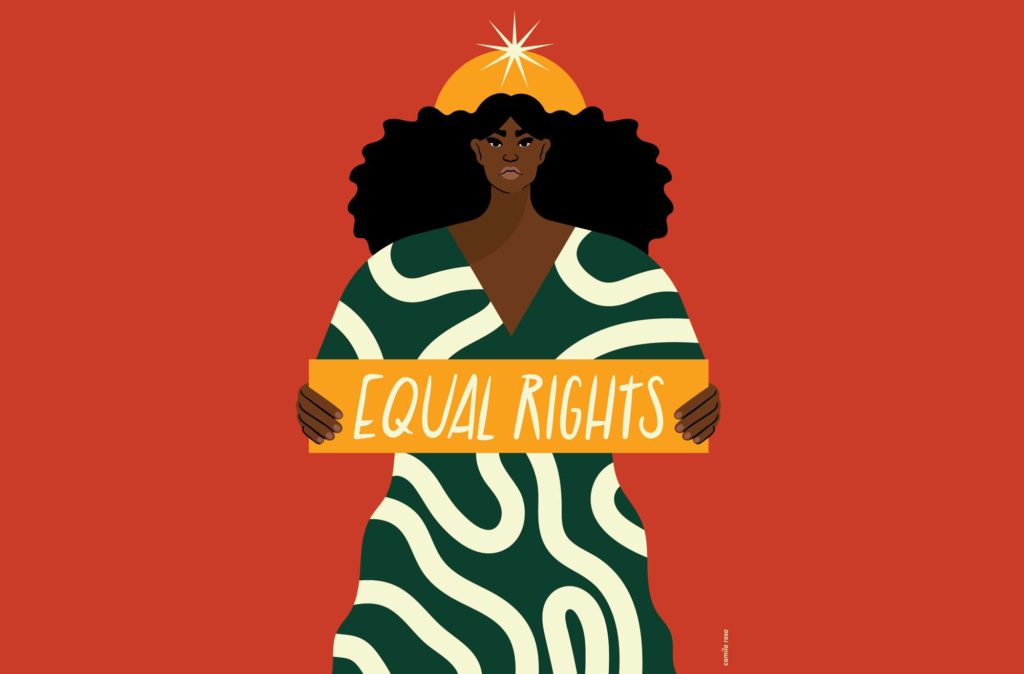After decades of obscurity, the Equal Rights Amendment to the US Constitution is seeing new momentum, thanks to the #MeToo movement and the Trump Effect.
by Laura L. Dunn, J. D., 2018 TED Fellow
Illustration by Camila Rosa
During the historic Seneca Falls rally in 1923, suffragist Alice Paul put forth a Constitutional Amendment that became the blueprint for the 1972 Equal Rights Amendment (ERA). Our foremothers were not merely seeking the right to vote; they wanted full gender equality under the law (amen!). The ERA is important, because it states, in part, “Equality of rights under the law shall not be denied or abridged by the United States or by any state on account of sex.” After decades of obscurity, the Equal Rights Amendment to the US Constitution is seeing new momentum thanks to the #MeToo era and the Trump Effect.
Passing a Constitutional amendment is quite a Herculean task. It took the women’s rights movement 49 years to lobby Congress to put forward the ERA to the states. And when Congress did in 1972, despite there being no time limit for ratification under the Constitution, it added a seven-year deadline to its legislative proposal.
For the first two years, the ERA enjoyed immediate momentum, passing in 22 of the needed 38 states in 1972, and then another eight states in 1973. However, momentum began to slow with only three states ratifying in 1974, one in 1975, none in 1976, and one in 1977. This brought the ERA within three states of passing with two years left on the deadline. Activists lobbied Congress to extend the deadline until 1982. Despite these efforts, there was a growing conservative movement that took on the ERA to kill its momentum and leave the amendment sitting for decades without any progress.
While women’s rights activists burnt their bras in the street and marched in support of the ERA, conservatives claimed the ERA would disrupt traditional family values, result in women’s service in the military, allow same-sex marriage, and reinforce reproductive rights, including access to abortion. In response to this backlash, four state legislatures rescinded their ratification, and the ERA lost momentum and slipped away into obscurity.
Despite the popular vote being in her favor, the country failed to elect the first female president in 2016. Instead, the electoral college placed one of the most morally and ethically questionable male presidents in office. This man is accused of harassing and abusing women, and in response, people are resisting—women are running for political office and people are mobilizing in the streets. The Trump Effect has reignited the #MeToo movement, which is bringing new life to the ERA. In 2017, Nevada ratified it, and in May 2018, Illinois did, too. For those of you keeping count, this brings the amendment within one state of the three-fourths the Constitution requires for full ratification. Though there are open questions regarding the effect (if any) of the congressional deadline, or four-state rescission efforts, many legal scholars believe all that is needed is the constitutional requirement of three-fourths ratification (TBD).
While we #resist the abusive Trump administration and say #timesup to the
sexual abusers revealed by #MeToo, we really need to start
saying it’s time for the ERA.
Of those the 13 states that haven’t passed the ERA, seven have passed it within one house of its bicameral legislature: Florida, Louisiana, Missouri, North Carolina, Oklahoma, South Carolina, and Virginia. These are the states that need a major grassroots surge of support, as well as progressive candidates pushing for the ERA as part of their political platforms. The Feminist Majority Foundation and National Organization of Women (NOW) are mobilizing today. Of the remaining six states, three have not made any effort to pass the ERA: Utah, Alabama, and Georgia, and three have repeatedly failed to ratify the ERA even in one house: Arkansas, Arizona, and Mississippi.
While we #resist the abusive Trump administration and say #timesup to the sexual abusers revealed by #MeToo, we really need to start saying it’s time for the ERA. It is absurd that in this day and time, gender equality is not guaranteed in America at the core of our Constitution. While there are some protections against it within the Fourteenth Amendment, the venerable and notorious R.B.G., US Supreme Court Justice Ruth Bader Ginsburg, has argued this is insufficient to ensure gender equality. As a way to #resist and say #TimesUp, nothing could be more powerful than passing the ERA.
As the famous Black Panther leader, Assata Shakur, famously said, “People get used to anything. The less you think about your oppression, the more your tolerance for it grows. After a while, people just think oppression is the normal state of things. But to become free, you have to be acutely aware of being a slave.” Our foremothers left us with some unfinished business. Between the Trump Effect and #MeToo movement, we have regained the momentum needed to finish this job and pass the ERA today.
Contact the Feminist Majority Foundation (feminist.org, East Coast: 703-522-2214, West Coast: 310-556-2500) and National Organization of Women (NOW.org, 202-628-8669) to volunteer.


